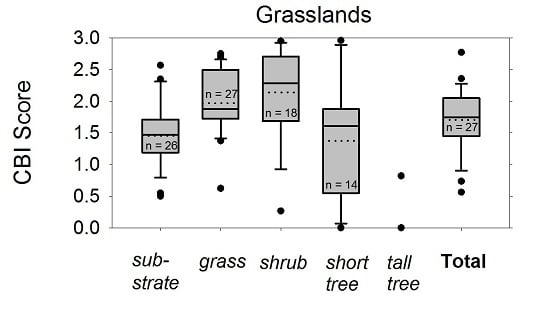Performance of Burn-Severity Metrics and Classification in Oak Woodlands and Grasslands
Abstract
:1. Introduction
2. Data and Methods
2.1. Study Site
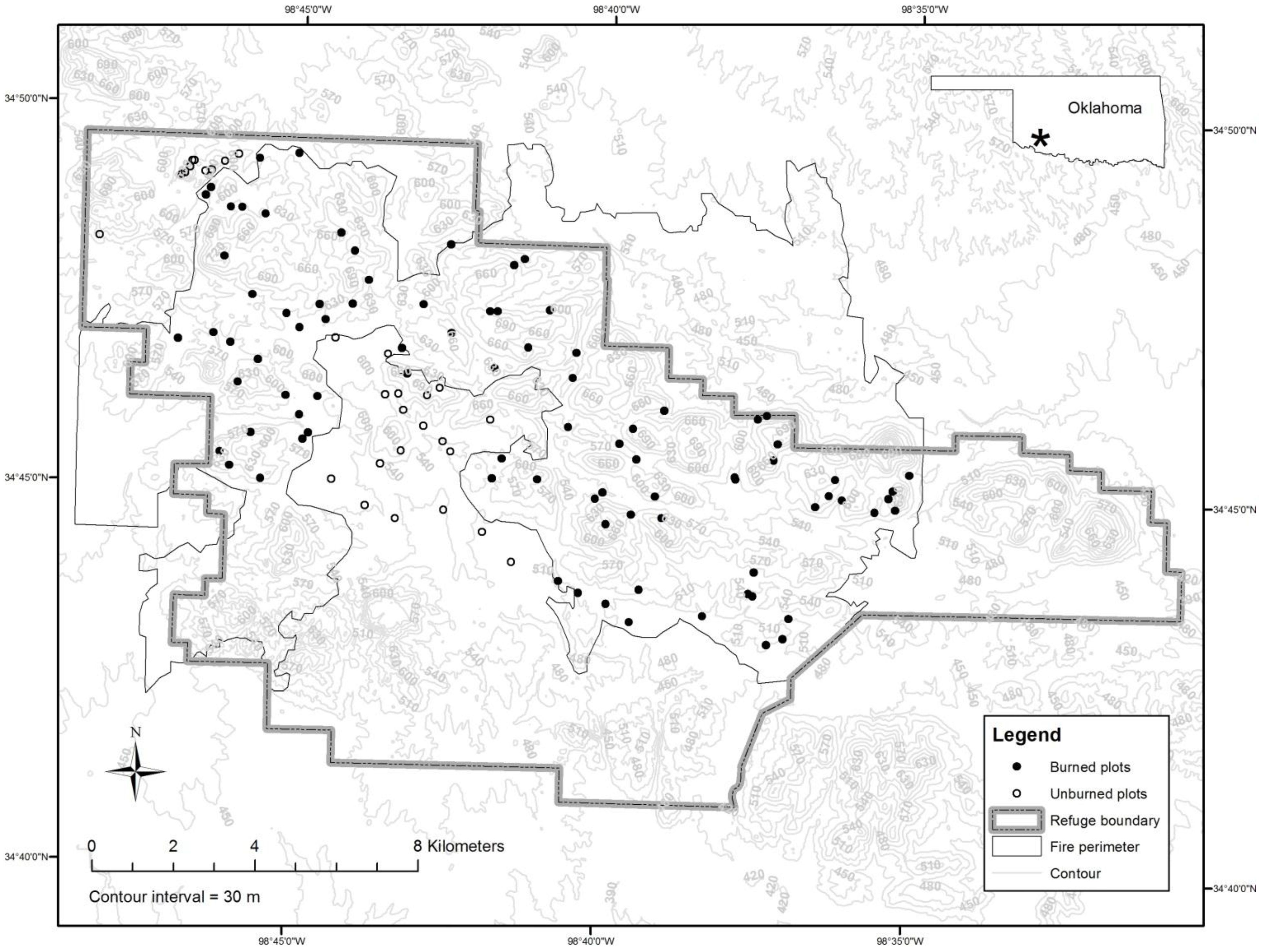
2.2. Sampling Design
2.3. Composite Burn Index (CBI)
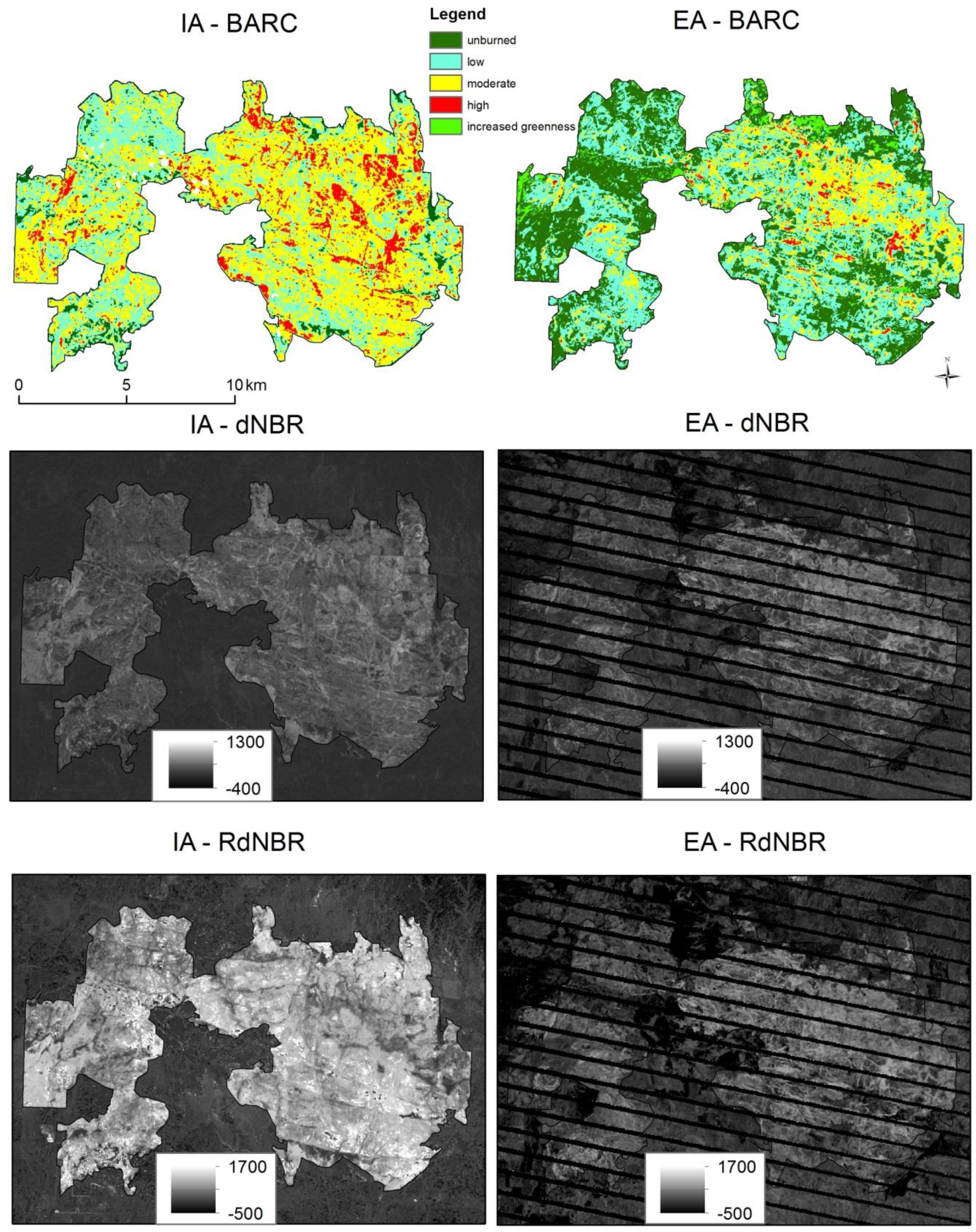
| Data | Collection Date(s) | Sampling Method |
|---|---|---|
| Pre-fire vegetation | 3/2010 to 6/2011 | 15 m radius plots |
| Post-fire vegetation | 8/2012 | 15 m radius plots |
| Composite Burn Index | 8/2012 | 15 m radius plots |
| Pre-fire imagery-Initial Assessment | 8/17/2011 | Landsat 5 TM |
| Post-fire imagery-Initial Assessment | 10/04/2011 | Landsat 5 TM |
| Pre-fire imagery-Extended Assessment | 5/29/2011 | Landsat 5 TM |
| Post-fire imagery-Extended Assessment | 5/23/2012 | Landsat 7 ETM+ |
2.4. Satellite Imagery and Pre-Processing
2.5. Data Analysis
3. Results
3.1. Composite Burn Index (CBI)
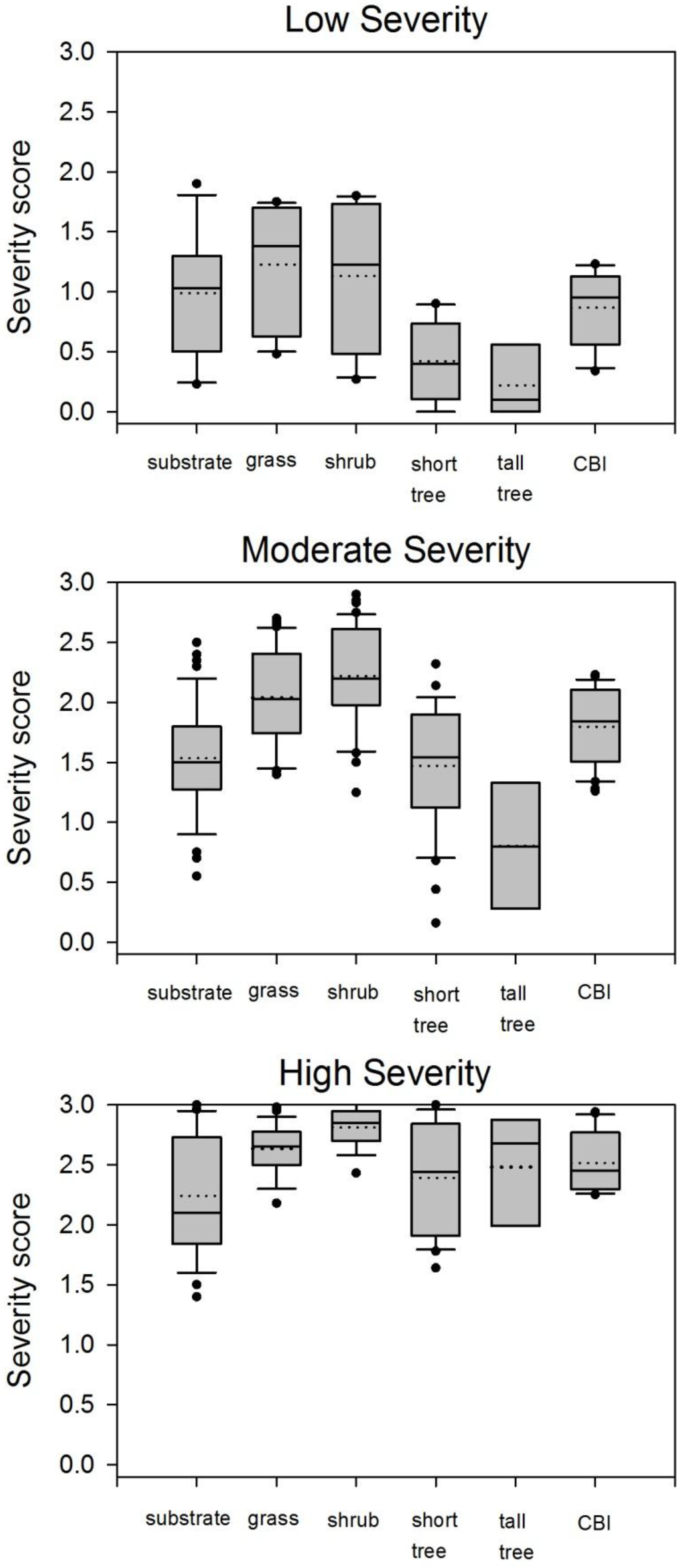

3.2. CBI and Satellite Classification
| Substrate | Herb/Grass | Shrub | Short Tree | Tall Tree | CBI | ||||
|---|---|---|---|---|---|---|---|---|---|
| no cell interpolation | Initial | dNBR | r | 0.48 | 0.43 | 0.42 | 0.46 | 0.63 | 0.74 |
| p | <.0001 | <0.0001 | 0.0001 | <0.0001 | 0.0164 | <0.0001 | |||
| n | 90 | 91 | 81 | 73 | 14 | 120 | |||
| RdNBR | r | 0.33 | 0.25 | 0.39 | 0.45 | 0.49 | 0.66 | ||
| p | 0.0015 | 0.0151 | 0.0003 | <0.0001 | 0.0783 | <0.0001 | |||
| n | 90 | 91 | 81 | 73 | 14 | 120 | |||
| Extended | dNBR | r | 0.45 | 0.32 | 0.32 | 0.42 | 0.67 | 0.59 | |
| p | <0.0001 | 0.0018 | 0.0033 | 0.0003 | 0.0081 | <0.0001 | |||
| n | 90 | 91 | 81 | 73 | 14 | 120 | |||
| RdNBR | r | 0.41 | 0.30 | 0.32 | 0.40 | 0.72 | 0.18 | ||
| p | <0.0001 | 0.0037 | 0.0035 | 0.0004 | 0.004 | 0.0472 | |||
| n | 90 | 91 | 81 | 72 | 14 | 91 | |||
| interpolation | Initial | dNBR | r | 0.51 | 0.43 | 0.43 | 0.48 | 0.59 | 0.78 |
| p | <0.0001 | <0.0001 | <0.0001 | <0.0001 | 0.027 | <0.0001 | |||
| n | 90 | 91 | 81 | 73 | 14 | 120 | |||
| RdNBR | r | 0.40 | 0.32 | 0.54 | 0.49 | 0.75 | 0.76 | ||
| p | <0.0001 | 0.0017 | <0.0001 | <0.0001 | 0.0021 | <0.0001 | |||
| n | 90 | 91 | 81 | 73 | 14 | 120 | |||
| Extended | dNBR | r | 0.44 | 0.30 | 0.30 | 0.40 | 0.66 | 0.59 | |
| p | <0.0001 | 0.0044 | 0.0064 | 0.0004 | 0.01 | <0.0001 | |||
| n | 90 | 91 | 81 | 73 | 14 | 120 | |||
| RdNBR | r | 0.38 | 0.29 | 0.31 | 0.39 | 0.71 | 0.55 | ||
| p | 0.0003 | 0.005 | 0.0053 | 0.0006 | 0.0045 | <0.0001 | |||
| n | 90 | 91 | 81 | 73 | 14 | 120 |
3.3. Predictive Models of Burn Severity and Thresholding
| Variable | Parameter Estimate | SE | Probability > t | Model Probability > F | Adjusted R2 |
|---|---|---|---|---|---|
| All plots (n = 120) | |||||
| dNBR_IA | <0.001 | 0.61 | |||
| Intercept | 59.91863 | 16.93055 | 0.0006 | ||
| CBI | 132.61502 | 9.76113 | <0.0001 | ||
| RdNBR_IA | |||||
| Intercept | 88.9992 | 49.41016 | 0.0742 | <0.001 | 0.57 |
| CBI | 359.14602 | 28.48691 | <0.0001 | ||
| dNBR_EA | |||||
| Intercept | −66.04456 | 28.40856 | 0.0056 | <0.001 | 0.35 |
| CBI | 108.52425 | 13.49596 | <0.0001 | ||
| RdNBR_EA | |||||
| Intercept | −79.28319 | 42.58894 | 0.0651 | <0.001 | 0.30 |
| CBI | 173.74911 | 24.55421 | <0.0001 | ||
| Woodlands (n = 86) | |||||
| dNBR_IA | <0.001 | 0.69 | |||
| Intercept | 50.92341 | 17.82425 | 0.0054 | ||
| CBI | 137.77572 | 10.02647 | <0.0001 | ||
| RdNBR_IA | |||||
| Intercept | 40.5572 | 39.24262 | 0.3043 | <0.001 | 0.74 |
| CBI | 341.74184 | 22.07469 | <0.0001 | ||
| Grasslands (n = 34) | |||||
| dNBR_IA | <0.001 | 0.38 | |||
| Intercept | 89.38738 | 41.63793 | 0.0395 | ||
| CBI | 114.00274 | 25.70259 | 0.0001 | ||
| RdNBR_IA | |||||
| Intercept | 159.81218 | 134.76715 | 0.2444 | <0.001 | 0.47 |
| CBI | 442.91999 | 83.19011 | <0.0001 | ||
| Burn Severity Classes | |||||||||
|---|---|---|---|---|---|---|---|---|---|
| Unchanged | Low | Moderate | High | ||||||
| CBI Values a | 0 to 0.1 | 0.1 to 1.24 | 1.25 to 2.24 | 2.25 to 3.0 | |||||
| Definition | One year after the fire the area was indistinguishable from pre-fire conditions. This does not always indicate the area did not burn | Areas of surface fire occurred with little change in cover and little mortality of the structurally dominant vegetation | The area exhibits a mixture of effects ranging from unchanged to high severity within the scale of one pixel (30 m2) | Vegetation has high to 100% mortality | |||||
| All land-types | Threshold values | ||||||||
| Initial Assessment | |||||||||
| dNBR * | 73 | 225 | 358 | ||||||
| RdNBR | 123 | 536 | 895 | ||||||
| Extended Assessment | |||||||||
| dNBR | −56 | 69 | 178 | ||||||
| RdNBR | −63 | 137 | 311 | ||||||
| Woodlands | |||||||||
| Initial Assessment | |||||||||
| dNBR † | 64 | 222 | 360 | ||||||
| RdNBR | 73 | 466 | 808 | ||||||
| Grasslands | |||||||||
| Initial Assessment | |||||||||
| dNBR | 100 | 231 | 345 | ||||||
| RdNBR * | 202 | 711 | 1154 | ||||||
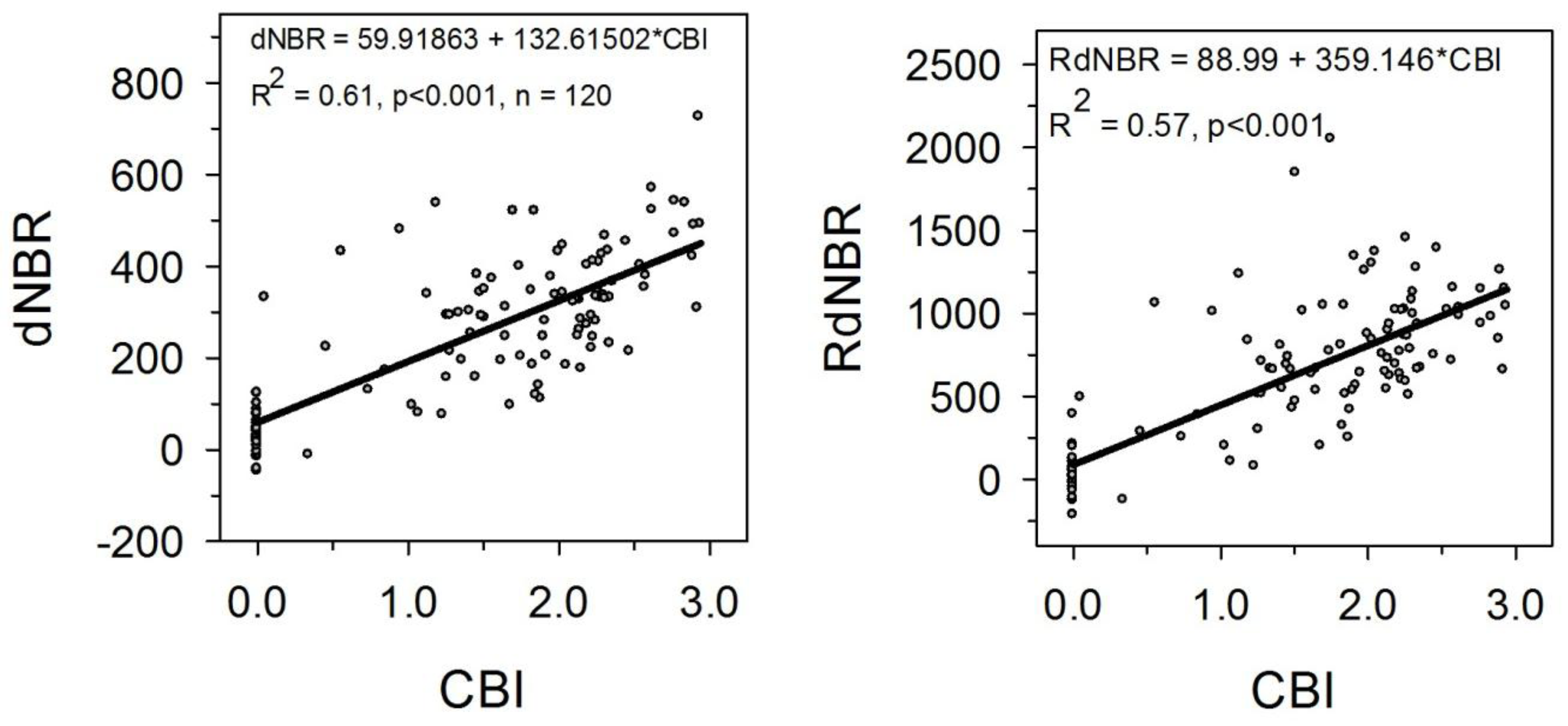
3.4. Accuracy Assessment
| Method | Overall Accuracy | User’s Accuracy | Producer’s Accuracy | ||||||
|---|---|---|---|---|---|---|---|---|---|
| unb. | low | mod | high | unb. | low | mod | high | ||
| All land-types | |||||||||
| dNBR_IA | 43.3 | 100.0 | 13.0 | 61.1 | 61.1 | 6.7 | 54.5 | 66.0 | 37.9 |
| RdNBR_IA | 44.2 | - | 16.7 | 60.3 | 53.3 | 0.0 | 63.6 | 76.0 | 27.6 |
| dNBR_EA | 43.3 | 100.0 | 10.9 | 57.4 | 90.9 | 6.7 | 45.5 | 70.0 | 34.5 |
| RdNBR_EA | 37.5 | - | 10.6 | 51.5 | 100.0 | 0.0 | 45.5 | 70.0 | 17.2 |
| Woodlands | |||||||||
| dNBR_IAwood | 47.7 | 100.0 | 12.9 | 60.5 | 80.0 | 8.7 | 57.1 | 71.9 | 50.0 |
| RdNBR_IAwood | 55.8 | 83.3 | 15.4 | 68.6 | 78.9 | 21.7 | 57.1 | 75.0 | 62.5 |
| Grasslands | |||||||||
| dNBR_IAgrass | 44.1 | - | 15.4 | 66.7 | 33.3 | 0.0 | 50.0 | 66.7 | 20.0 |
| RdNBR_IAgrass | 44.1 | - | 15.4 | 68.4 | 0.0 | 0.0 | 50.0 | 72.2 | 0.0 |
| MTBS | - | - | 19.4 | 65.6 | 57.1 | - | 54.5 | 42.0 | 55.2 |
4. Discussion
4.1. Application of CBI
4.2. Satellite Imagery Classification
4.3. Recommended Methods for Validating Future Fire Severity Maps in Oak Woodlands
5. Conclusions
Acknowledgments
Author Contributions
Conflicts of Interest
References
- De Santis, A.; Chuvieco, E. Burn severity estimation from remotely sensed data: Performance of simulation versus empirical models. Remote Sens. Environ. 2007, 108, 422–425. [Google Scholar] [CrossRef]
- Boer, M.M.; Macfarlane, C.; Norris, J.; Sadler, R.J.; Wallace, J.; Grierson, P.F. Mapping burned areas and burn severity patterns in SW Australian eucalypt forest using remotely-sensed changes in leaf area index. Remote Sens. Environ. 2008, 112, 4358–4369. [Google Scholar] [CrossRef]
- Wang, Z.; Jiang, L.; Kong, B.; Chen, H.; Zhang, T. Remote sensing measure of severity on the Zhalong wetlands and consequent ecological effects. In Proceedings of the Third International Workshop on Earth Observation and Remote Sensing Applications, Changsha, China, 11–14 June 2014.
- Salvia, M.; Ceballos, D.; Grings, F.; Karszenbaum, H.; Kandus, P. Post-fire effects in wetland environments: Landscape assessment of plant coverage and soil recovery in the Paraná River delta marshes, Argentina. Fire Ecol. 2012, 8, 17–37. [Google Scholar] [CrossRef]
- Wiens, J.; Sutter, R.; Anderson, M.; Blanchard, J.; Barnett, A.; Aguilar-Amuchastegui, N.; Avery, C.; Laine, S. Selecting and conserving lands for biodiversity: The role of remote sensing. Remote Sens. Environ. 2009, 113, 1370–1381. [Google Scholar] [CrossRef]
- Kulakowski, D.; Veblen, T.T. Effect of prior disturbances on the extent and severity of wildfire in Colorado subalpine forests. Ecology 2007, 88, 759–769. [Google Scholar] [CrossRef] [PubMed]
- Perry, D.A.; Hessburg, P.F.; Skinner, C.N.; Spies, T.A.; Stephens, S.L.; Taylor, A.H.; Franklin, J.F.; McComb, B.; Riegel, G. The ecology of mixed severity fire regimes in Washington, Oregon, and Northern California. Forest Ecol. Manag. 2011, 262, 703–717. [Google Scholar] [CrossRef]
- Koldan, C.A.; Rogan, J. Mapping wildfire burn severity in the Arctic Tundra from downsampled MODIS data. Arct. Antarct. Alp. Res. 2013, 45, 64–76. [Google Scholar] [CrossRef]
- Twidwell, D.T.; Rogers, W.E.; McMahon, E.A.; Thomas, B.R.; Kreuter, U.P.; Blankenship, T.L. Prescribed extreme fire effects on richness and invasion in coastal prairie. Invasive Plant Sci. Manag. 2012, 5, 330–340. [Google Scholar] [CrossRef]
- Williams, M.A.; Baker, W.L. Spatially extensive reconstructions show variable-severity fire and heterogeneous structure in historical western United States dry forests. Glob. Ecol. Biogeogr. 2012, 21, 1042–1052. [Google Scholar] [CrossRef]
- Fulé, P.Z.; Swetnam, T.W.; Brown, P.M.; Falk, D.A.; Peterson, D.L.; Allen, C.D. Unsupported inferences of high severity fire in historical western United States dry forests: Response to Williams and Baker. Glob. Ecol. Biogeogr. 2013, 23, 825–830. [Google Scholar] [CrossRef]
- Ryan, K.C.; Noste, N.V. Evaluating prescribed fires. In Proceedings of the Symposium and Workshop on Wilderness Fire, Missoula, MT, USA, 15–18 November 1983.
- Keeley, J.E. Fire intensity, fire severity and burn severity: A brief review and suggested usage. Int. J. Wildland Fire 2009, 18, 116–126. [Google Scholar] [CrossRef]
- Morgan, P.; Keane, R.E.; Dillon, G.K.; Jain, T.B.; Hudak, A.T.; Karau, E.C.; Sikkink, P.G.; Holden, Z.A.; Strand, E.K. Challenges of assessing fire and burn severity using field measures, remote sensing and modelling. Int. J. Wildland Fire 2014, 23, 1045–1060. [Google Scholar] [CrossRef]
- Stroppiana, D.; Azar, R.; Calò, F.; Pepe, A.; Imperatore, P.; Boschetti, M.; Silva, J.M.N.; Brivio, P.; Lanari, R. Integration of optical and SAR data for burned area mapping in Mediterraean regions. Remote Sens. 2014, 7, 1320–1345. [Google Scholar] [CrossRef]
- Pierce, A.D.; Farris, C.A.; Taylor, A.H. Use of random forests for modeling and mapping forest canopy fuels for fire behavior analysis in Lassen Volcanic National Park, California, USA. Forest Ecol. Manag. 2012, 279, 77–89. [Google Scholar] [CrossRef]
- Bolton, D.K.; Coops, N.C.; Wulder, M.A. Characterizing residual structure and forest recovery following high-severity fire in the western boreal of Canada using Landsat time-series and airborne LiDAR data. Remote Sens. Environ. 2015, 163, 48–60. [Google Scholar] [CrossRef]
- Miller, J.D.; Knapp, E.E.; Key, C.H.; Skinner, C.N.; Isbell, C.J.; Creasy, R.M.; Sherlock, J.W. Calibration and validation of the relative differenced Normalized Burn Ratio (RdNBR) to three measures of fire severity in the Sierra Nevada and Klamath Mountains, California, USA. Remote Sens. Environ. 2009, 113, 645–656. [Google Scholar] [CrossRef]
- Hessburg, P.F.; Agee, J.K.; Franklin, J.F. Dry forests and wildland fires of the inland Northwest USA: Contrasting the landscape ecology of the pre-settlement and modern eras. Forest Ecol. Manag. 2005, 211, 117–139. [Google Scholar] [CrossRef]
- Prichard, S.J.; Kennedy, M.C. Fuel treatments and landform modify landscape patterns of burn severity in an extreme fire event. Ecol. Appl. 2014, 24, 571–590. [Google Scholar] [CrossRef] [PubMed]
- Wimberly, M.C.; Cochrane, M.A.; Baer, A.D.; Pabst, K. Assessing fuel treatment effectiveness using satellite imagery and spatial statistics. Ecol. Appl. 2009, 19, 1377–1384. [Google Scholar] [CrossRef] [PubMed]
- Miller, J.D.; Safford, H.D. Trends in wildfire severity 1984–2010 in the Sierra Nevada, Modoc Plateau and southern Cascades, California, USA. Fire Ecol. 2012, 8, 41–57. [Google Scholar] [CrossRef]
- Parks, S.A.; Miller, C.; Nelson, C.R.; Holden, Z.A. Previous fires moderate burn severity of subsequent wildland fires in two large western US wilderness areas. Ecosystems 2014, 17, 29–42. [Google Scholar] [CrossRef]
- Johnstone, J.F.; Rupp, T.S.; Olson, M.; Verbyla, D. Modeling impacts of fire severity on successional trajectories and future fire behavior in Alaskan boreal forests. Landsc. Ecol. 2011, 26, 487–500. [Google Scholar] [CrossRef]
- Russell, R.E.; Saab, V.A.; Dudley, J.G. Habitat-suitability models for cavity-nesting birds in a postfire landscape. J. Wildl. Manag. 2007, 71, 2600–2611. [Google Scholar] [CrossRef]
- Key, C.H.; Benson, N.C. Landscape Assessment (LA): Sampling and analysis methods. In FIREMON: Fire Effects Monitoring and Inventory System; Lutes, D.C., Keane, R.E., Caratti, C.H., Key, N.C., Sutherland, S., Eds.; Rocky Mountain Research Station, USDA Forest Service: Fort Collins, CO, USA, 2006; p. 51. [Google Scholar]
- Montealegre, A.L.; Lamelas, M.T.; Tanase, M.A.; de la Riva, J. Forest fire severity assessment using ALS data in a mediterranean environment. Remote Sens. 2014, 6, 4240–4265. [Google Scholar] [CrossRef]
- Tanase, M.A.; Santoro, M.; Wegmüller, U.; de la Riva, J.; Pérez-Cabello, F. Properties of X-, C- and L-band repeat-pass interferometric SAR coherence in Mediterranean pine forests affected by fires. Remote Sens. Environ. 2010, 114, 2182–2194. [Google Scholar] [CrossRef]
- Key, C.H. Ecological and sampling constraints on defining landscape fire severity. Fire Ecol. 2006, 2, 34–59. [Google Scholar] [CrossRef]
- Cansler, C.A.; McKenzie, D. How robust are burn severity indices when applied in a new region? Evaluation of alternate field-based and remote-sensing methods. Remote Sens. 2012, 4, 456–483. [Google Scholar] [CrossRef]
- Picotte, J.J.; Robertson, K.M. Validation of remote sensing of burn severity in south-eastern US ecosystems. Int. J. Wildl. Fire 2011, 20, 453–464. [Google Scholar] [CrossRef]
- Buck, P. Relationships of the woody vegetation of the Wichita Mountains Wildlife Refuge to geological formations and soil types. Ecology 1964, 45, 336–344. [Google Scholar] [CrossRef]
- National Climate Data Center (NCDC). Monthly Surface Data. National Climate Data Center: Asheville, North Carolina, USA, 1999. Available online: http://www.ncdc/noaa.gov/ (accessed on 28 May 2009). [Google Scholar]
- Stambaugh, M.C.; Marschall, J.M.; Guyette, R.P. Linking fire history to successional changes of xeric oak woodlands. Forest Ecol. Manag. 2014, 320, 83–95. [Google Scholar] [CrossRef]
- Hammer, L.D.; Stambaugh, M.C. Environmental gradients and controls of eastern redcedar (Juniperus virginiana L.) expansion from ancient refugia. Biol. Invasions 2015, in press. [Google Scholar]
- U.S. Drought Monitor. 2013. Available online: http://droughtmonitor.unl.edu/monitor.html (accessed on 9 July 2013).
- Gesch, D.; Evans, G.; Mauck, J.; Hutchinson, J.; Carswell, W.J., Jr. The National Map—Elevation: U.S. Geological Survey Fact Sheet 2009-3053. Available online: http://ned.usgs.gov (accessed on 1 April 2015).
- Hoagland, B. The vegetation of Oklahoma: A classification for landscape mapping and conservation planning. Southwest. Nat. 2000, 45, 385–420. [Google Scholar] [CrossRef]
- Eidenshink, J.; Schwind, B.; Brewer, K.; Zhu, Z.L.; Quayle, B.; Howard, S. A project for monitoring trends in burn severity. Fire Ecol. 2007, 3, 3–21. [Google Scholar] [CrossRef]
- Key, C.H.; Benson, N.C. Measuring and remote sensing of burn severity: The CBI and NBR. In Proceedings of the Joint Fire Science Conference and Workshop, Boise, ID, USA, 15–17 June 1999.
- Brewer, C.K.; Winne, J.C.; Redmond, R.L.; Opitz, D.W.; Mangrich, M.V. Classifying and mapping wildfire severity: A comparison of methods. Photogramm. Eng. Remote Sens. 2005, 71, 1311–1320. [Google Scholar] [CrossRef]
- Miller, J.D.; Thode, A.E. Quantifying burn severity in a heterogeneous landscape with a relative version of the delta Normalized Burn Ratio (dNBR). Remote Sens. Environ. 2007, 109, 66–80. [Google Scholar] [CrossRef]
- Wimberly, M.C.; Reilly, M.J. Assessment of fire severity and species diversity in the southern Appalachians using Landsat TM and ETM+ imagery. Remote Sens. Environ. 2007, 108, 189–197. [Google Scholar] [CrossRef]
- De Santis, A.; Chuvieco, E. GeoCBI: A modified version of the Composite Burn Index for the initial assessment of the short-term burn severity from remotely sensed data. Remote Sens. Environ. 2009, 113, 554–562. [Google Scholar] [CrossRef]
- Roy, D.P.; Boschetti, L.; Trigg, S.N. Remote sensing of fire severity: assessing the performance of the normalized burn ratio. IEEE Geosci. Remote Sens. Lett. 2006, 3, 112–116. [Google Scholar] [CrossRef]
- Parks, S.A.; Dillon, G.K.; Miller, C. A new metric for quantifying burn severity: The relativized burn ratio. Remote Sens. 2014, 6, 1827–1844. [Google Scholar] [CrossRef]
© 2015 by the authors; licensee MDPI, Basel, Switzerland. This article is an open access article distributed under the terms and conditions of the Creative Commons Attribution license (http://creativecommons.org/licenses/by/4.0/).
Share and Cite
Stambaugh, M.C.; Hammer, L.D.; Godfrey, R. Performance of Burn-Severity Metrics and Classification in Oak Woodlands and Grasslands. Remote Sens. 2015, 7, 10501-10522. https://doi.org/10.3390/rs70810501
Stambaugh MC, Hammer LD, Godfrey R. Performance of Burn-Severity Metrics and Classification in Oak Woodlands and Grasslands. Remote Sensing. 2015; 7(8):10501-10522. https://doi.org/10.3390/rs70810501
Chicago/Turabian StyleStambaugh, Michael C., Lyndia D. Hammer, and Ralph Godfrey. 2015. "Performance of Burn-Severity Metrics and Classification in Oak Woodlands and Grasslands" Remote Sensing 7, no. 8: 10501-10522. https://doi.org/10.3390/rs70810501
APA StyleStambaugh, M. C., Hammer, L. D., & Godfrey, R. (2015). Performance of Burn-Severity Metrics and Classification in Oak Woodlands and Grasslands. Remote Sensing, 7(8), 10501-10522. https://doi.org/10.3390/rs70810501




